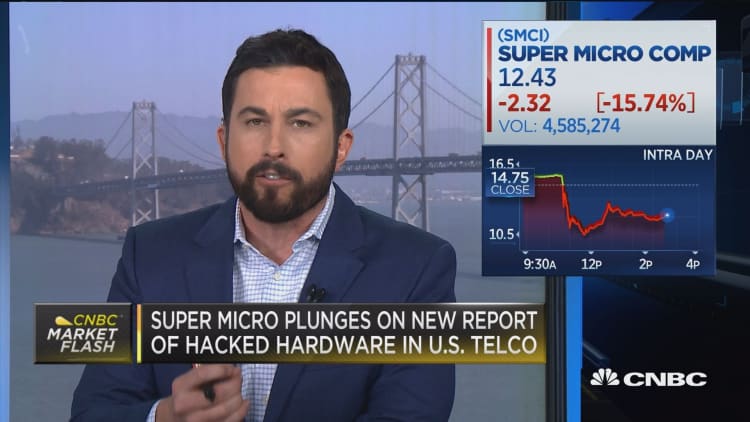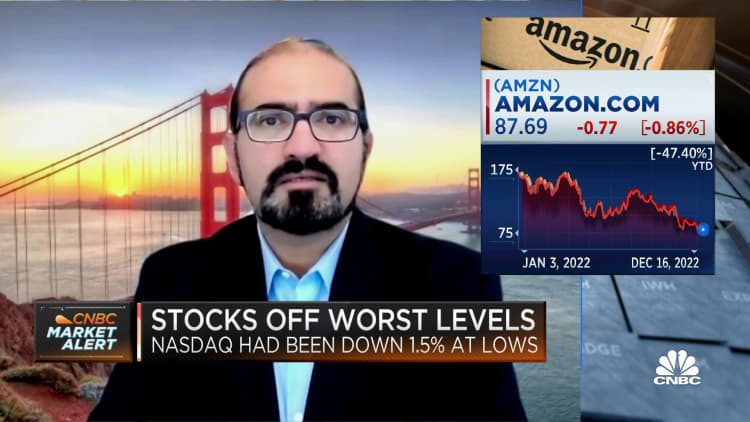Tech stocks got whacked in 2022 — but one server maker soared almost 90%, beating all its peers
Charles Liang, CEO, Super Micro
Source: Supermicro
It’s been a brutal year for tech stocks. The Nasdaq is headed for its worst slump since 2008 and is poised to underperform the S&P 500 for a second straight year. Among mega-cap tech stocks, Amazon, Meta and Tesla have each lost at least half their value.
Investors looking for some sign of optimism can turn to a 29-year-old server maker located in the heart of Silicon Valley. Shares of Super Micro Computer have soared 89% in 2022, topping all other U.S. tech companies valued at $1 billion or more. Supermicro has a market cap of $4.4 billion, up from $2.4 billion at the start of the year.
Supermicro manufactures computers and sells them to companies, which use them as servers for websites, data storage and applications like artificial intelligence algorithms. In the low-margin server business, Supermicro competes with Dell, IBM and Hewlett Packard Enterprise as well as lesser-known players such as China’s Inspur. According to estimates from The Next Platform, Supermicro had about 2.6% of the market in 2021.
Supermicro has sought to differentiate itself in the market by allowing customers to more easily customize their computers. That makes for a more profitable offering than off-the-shelf servers.
The strategy has been working. Supermicro reported 46% growth in its fiscal 2022, which ended in June, to $5.2 billion in revenue. Earnings per share climbed to $5.32 in 2022 from $2.09 in 2021 and $1.60 the year before that.
“The stock is actually just simply mirroring the EPS increases we have seen over two years,” said Nehal Chokshi, an analyst at Northland Capital Markets who recommends buying the stock. Chokshi has a price target of $165, by far the highest among five analysts tracked by FactSet.
Supermicro closed on Tuesday at $82.89.
Chokshi said that Supermicro’s profitability and growth have been strong enough that it might deserve a larger multiple. Yet even with this year’s rally, the stock is only trading at 8.6 times earnings over the next 12 months, which is lower than its five-year average of 9.5, according to FactSet. For the past 12 months, it trades at 10.1 times earnings, down from a five-year average of 17.8.
“There still hasn’t been multiple expansion,” Chokshi said. “A lot of investors, including myself, find that befuddling, because this is a name that has historically generated 20-plus percent revenue and EPS growth that’s trading only at 10 [times] earnings.”

Across the board, investors have taken a hatchet to tech multiples, reflecting concerns that soaring inflation and rising interest rates will dampen enthusiasm for growth stocks for the foreseeable future. The Nasdaq currently trades for 26 times earnings, compared with its five-year average of 35, according to FactSet.
Supermicro shares started rising in July and continued going up in August, after the company’s annual earnings report. They soared another 30% in November, after Supermicro showed a nearly 80% increase in year-over-year sales for the September quarter to $1.85 billion.
Manufacturing servers involves putting many different parts together. Supermicro starts with one of its own motherboards, plugs in a processor from Intel or AMD, or a graphics processor from Nvidia, and adds a power supply, RAM, networking and whatever other parts the computer might need. Supermicro will sell the client the motherboard, a fully assembled server, or an entire rack of servers.
Heading into 2023, the outlook for the server market is murky, especially in the early part of the year. Companies are tightening their belts, and likely to spend less on capital expenditures. Supermicro’s revenue growth is expected to moderate to about 32% in fiscal 2023 and 9% the following year.
But the company has at least regained the support of Wall Street after a rough stretch in the middle of the last decade. From 2015 through 2017, Supermicro had misstated financial statements and published some key filings late, according to the SEC.

“They have done a marvelous job of coming back,” said Susquehanna’s Mehdi Hosseini, who has a hold rating on the stock. “I would say they’re the comeback story of 2022. And that’s what’s reflected in the share price. But the management team has to remain very aggressive with their target.”
The comeback, according to Hosseini, is partially driven by confidence in CFO David Weigand, who has implemented strong internal financial controls since taking the job in early 2021.
“They became compliant with SEC filings in 2020, and it’s just been straight line up,” Hosseini said. “They have done really well.”
Bigger customers
Supermicro CEO Charles Liang told CNBC that the company’s recent performance reflects the size of the business and its ability to offer a wider array of products, particularly around customization.
While the company has been rapidly expanding in Taiwan, one component of its differentiation strategy, Liang said, is its San Jose, California, headquarters, where Supermicro still does the majority of its manufacturing.
Liang said it’s more expensive to build locally than overseas but doing so allows the company to be physically closer and more responsive to the chip companies it supplies as well as major customers like cloud providers and big websites.
“Silicon Valley enables us for better technology, faster time to market, and quick service, quick maintenance of our customer,” Liang said.
He said tech companies can move faster with Supermicro servers and are willing to pay for execution and the company’s design skills.
One area of notable growth is machine learning, or AI algorithms that require a large amount of computing power, usually centered around graphics processors made by Nvidia or AMD. Supermicro makes motherboards and systems that can combine up to eight GPUs together on a single board.
In the latest quarter, 45% of Supermicro’s revenue came from enterprise sales, including AI and machine learning products.
Another specialized market Supermicro is targeting is servers for 5G or telecom applications, using a new kind of approach called OpenRAN.
Supermicro is targeting $8 billion to $10 billion in revenue for fiscal 2024. To reach that goal, the company says it needs substantial growth from AI products and has to sell more complete systems, or servers already installed in a rack.
Current growth is being driven by Supermicro’s large data center business, which has been landing bigger accounts and comprised 50% of total sales in the September quarter, according to a November note from Wedbush analyst Matt Bryson, who has a neutral rating on the stock.
Supermicro said in November that a big unnamed customer was responsible for nearly 22% of the company’s sales in the quarter. In recent years, Supermicro had no single customer accounting for more than 10% of its sales.
‘Far more cautious’
Among analysts, there’s some skepticism that the company can hit its targets in a softer economic environment.
Susquehanna’s Hosseini said he recently downgraded the stock “because I think they will face headwinds in the next year” and the “growth targets are too aggressive.”
“While we applaud the quarter, we are far more cautious when thinking about Supermicro’s intermediate to longer term path and in particular view the company’s now stated goal of $8 billion to $10 billion in revenues in 2024 with trepidation given the headwinds noted above,” Wedbush’s Bryson wrote.
Analysts at Evercore said in a note this month that they expect server market revenue growth to slow to about 2.7% globally in 2023 from 13.5% last year. Server makers like Supermicro need to carry a lot of inventory and may face margin pressure if sales slow.
Northland’s Chokshi said that Supermicro’s strengths, especially in AI systems, could allow it to weather a market downturn better than its rivals.
“While their competitors are showing strong signs that there is a significant capex down cycle, their results are accelerating,” Chokshi said. “So far, they’re showing no signs of this cycle catching up to them.”
Liang is confident that Supermicro can continue to gain new customers, even if growth slows from its recent torrid pace.
“In a good year, growth will be around 80%,” he said. “In a bad year, hopefully 20%.”
WATCH: Tech stock expectations are coming down but not fast enough

For all the latest Technology News Click Here
For the latest news and updates, follow us on Google News.

